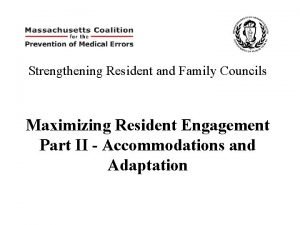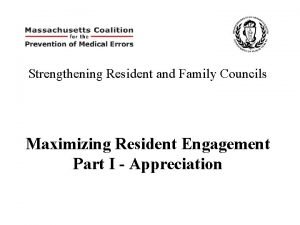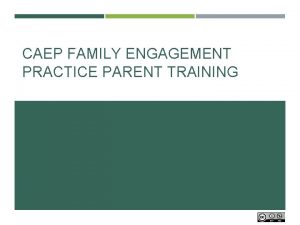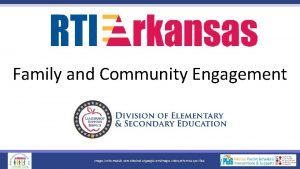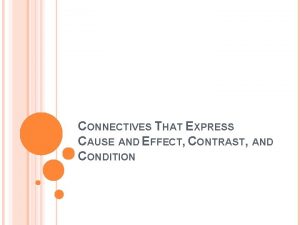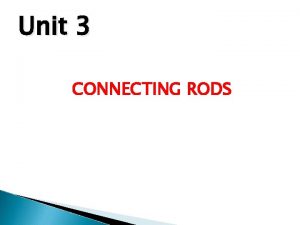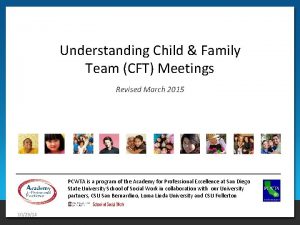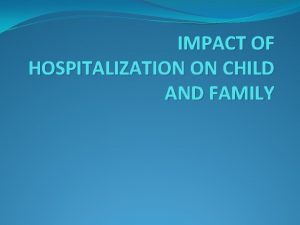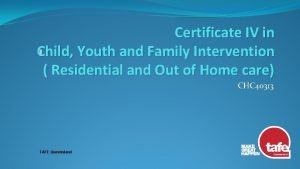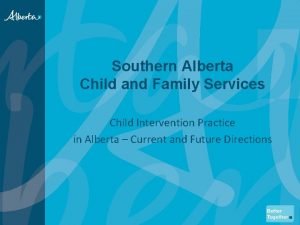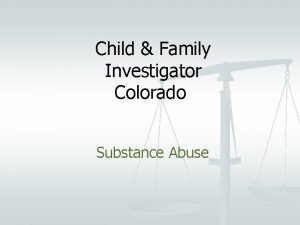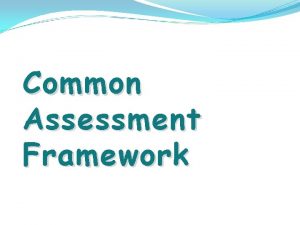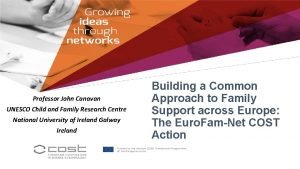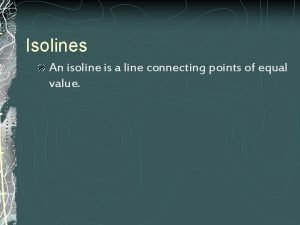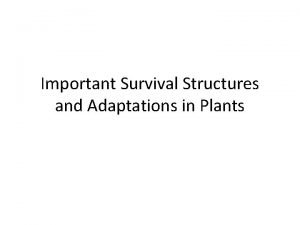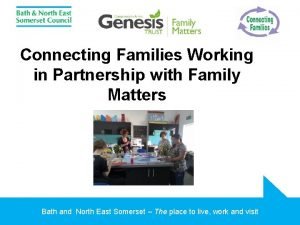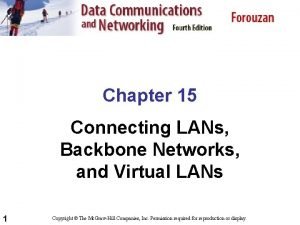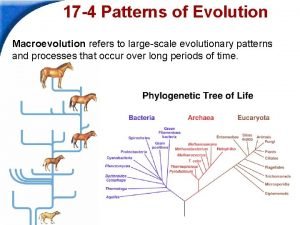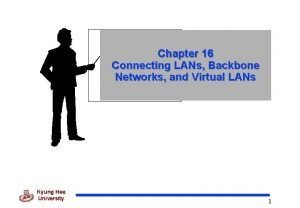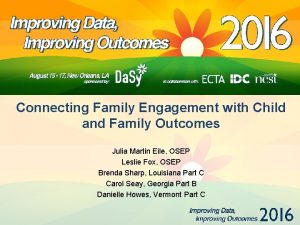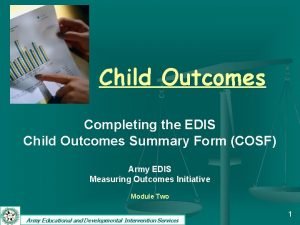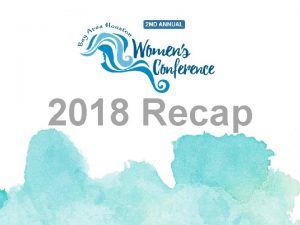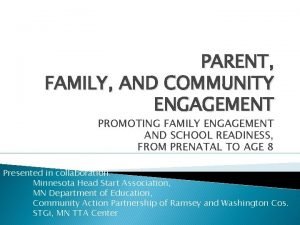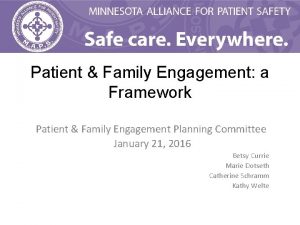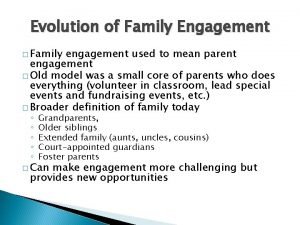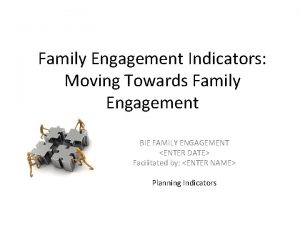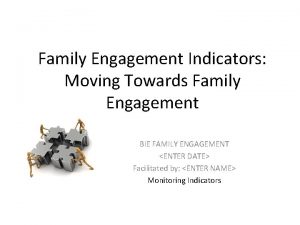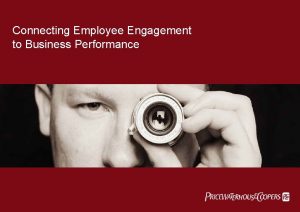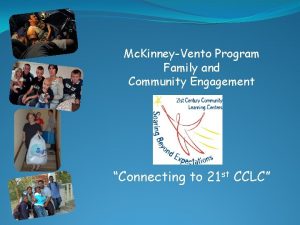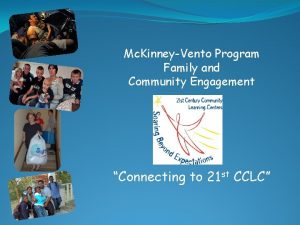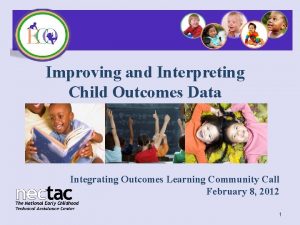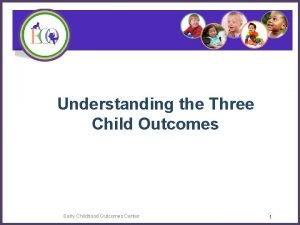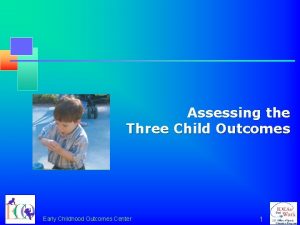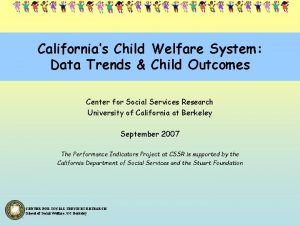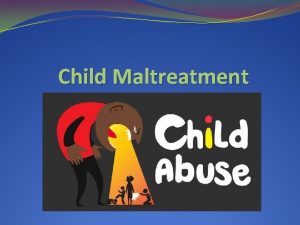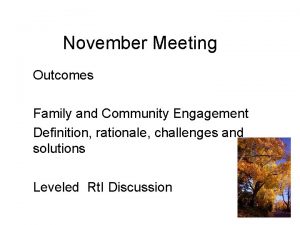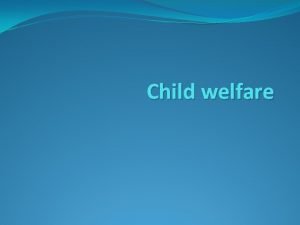Connecting Family Engagement with Child and Family Outcomes








































- Slides: 40

Connecting Family Engagement with Child and Family Outcomes Julia Martin Eile, OSEP Leslie Fox, OSEP Brenda Sharp, Louisiana Part C Carol Seay, Georgia Part B Danielle Howes, Vermont Part C

Purpose of the Session • To highlight key principles & recommendations from the ED/HHS joint policy statement on Family Engagement • To discuss how improving family engagement practices can lead to improvements in child and family outcomes. • Sharing of state examples of program improvements in engaging families. 2

Where to find the joint policy statement on Family Engagement

Policy Statement Purpose • Align the Frameworks with principles of effective family engagement 4

Policy Statement Purpose • Build a common language • Prioritize family engagement as an early childhood and educational strategy. • Provide guidance to the field for implementing highimpact family engagement practices. 5

Definition of Family Engagement Family engagement refers to the systematic inclusion of families in activities and programs that promote children’s development, learning, and wellness, including in the planning, development, and evaluation of such activities, programs, and systems. 6

Principles of Effective Family Engagement 1. Create continuity and consistency for children and families. 2. Value respectful and trusting relationships between families and professionals. 3. Develop goal-oriented relationships with families that are linked to children’s development and learning. 4. Engage families around children’s health, mental health and social and emotional well-being. 5. Ensure that all family engagement opportunities are culturally and linguistically responsive. 7

Principles of Effective Family Engagement 6. Build staff capacity to implement family engagement practice principles. 7. Support families’ connections and capabilities. 8. Systemically embed effective family engagement strategies within early childhood systems and programs. 9. Develop strong relationships with community partners that support families. 10. Continuously learn and improve. 10

Recommendations to Promote Family Engagement 1. Plan for and prioritize family engagement. 2. Communicate consistent messages that support strong family engagement. 3. Invest and allocate resources. 4. Establish policies, procedures, and practices that support family engagement. 5. Establish workforce capacity building that supports family engagement. 6. Develop and integrate family engagement data for continuous improvement in systems and programs. 9

Connections to the SSIP Linking Practices to Outcomes Program Activities & Practices • Referral & Intake • Child Assessment • Family Assessment • Team Meetings & Decision Making • Service Provision • Service Coordination • Selection of Staff • Training and Professional Development • Funding Streams • Program Philosophy Provider Practices • Use of Assessment Information • Communication skills with families • Knowledge of and experience with evidence-based practices • Team communication and decisionmaking • Coaching and consultation abilities • Fidelity Family • Family priorities and concerns • Learning preferences • Resources and needs • Number of caregivers • Location of services • Family Outcomes Child Outcomes • Improved Child Outcomes as measured by the State-identified Measurable Result

Louisiana Part C Brenda Sharp, Part C Coordinator 11

Louisiana’s SIMR The Early. Steps system will improve child outcomes through supports that are focused on family concerns, priorities, and resources and provided through a team-based approach. 3. Develop goal-oriented relationships with families that are linked to children’s development. 12

How we got here • 2008: Strategic Plan—a joint plan between the lead agency and the SICC. • Vision: A one-stop-shop with effective teaming and family-driven quality services for all children • Goal: The system will include family/professional training that incorporate partnerships that result in quality services with positive outcomes for children and families 6. Build staff capacity to implement family engagement principles and practices 13

Implementing the Strategic Plan • Focus on team-based service delivery for a more effective, streamlined system which maximizes resources. • Focus on improving quality of IFSPs 10. Continuously learn and improve 14

Moving to the SSIP • Our vision stayed the same: can’t improve child outcomes without the connection between family CPRs and IFSP outcomes • The difference is in the implementation • Phase I literature review of team-based service delivery as the evidence-based practice “Family Engagement promotes children’s learning and healthy development” 15

The Stars Begin to Align • Early Care and Education System Re-design • Relationship-based care: use of the CLASS to support improved child outcomes • Project LAUNCH Initiative • Brain development research • ACEs • Training in the LAUNCH pilot region on the PIWI: Parents Interacting with Infants 4. Engage families around children’s health, mental health and social and emotional well-being. 16

Next Steps • “Refresh” on family assessment-writing IFSP outcomes with implementation fidelity built in • Connect CLASS dimensions with provider strategies to support caregivers in early care and education settings • Continue to train early intervention provider teams in the PIWI • Develop measures for measuring improvement—aside from child outcome measures 8. Systematically embed effective family engagement strategies within early childhood systems and programs. 17

Georgia Part B Carol Seay, Part B Data Manager 18

GA’s Parent Mentor Partnership Mission of the Georgia Parent Mentor Partnership : To build effective family, school, and community partnerships that lead to greater achievement for students, especially those with disabilities. Vision of the Georgia Parent Mentor Partnership: Parent mentors and special education administrators will lead the way in Georgia to bridge the gap between home, school and community partnerships.

History 2002 – Six school districts in GA – Hired parents mentors to infuse family engagement into school and district activities Funding – GADOE – Local funds Duties and responsibilities – Provide information to parents of SWD – Assist in the navigating the special education system – Support teachers and administrators in planning and implementing activities to support facility involvement

Today 2016 – Over 108 parent mentors – Over 100 districts Funding – GADOE – Local funds Duties and responsibilities – Partner with special education directors – Embed family engagement into school and district initiatives The Georgia Parent Mentor Partnership quickly has become a model for families and schools working together to improve outcomes for students with disabilities.

Who are the Parent Mentors? Parents of children with disabilities • Who support other parents by providing information and resources to help their children succeed in school and transition from school to adult life • Who experienced special education first hand from the time their children transitioned into special education from early learning programs to the time they graduated and transitioned to post-school environments • Who navigated the special education process including the development of Individualized Educational Programs (IEPs) and the secondary transition plans • Who searched for resources for their children to support their successes at home, at school, and in the community

Professional Learning The DOE provides on-going training regarding special education and family engagement to support the work of Parent Mentors with other parents, teachers, administrators, and community members • New Parent Mentor Orientation – 1 ½ day training for new parent mentor • Parent Mentor Kickoff Conference – 2 ½ day retreat for all Parent Mentors • Quarterly regional meetings (6 regions) • Drive-in University (every other year) • Family Engagement Conference - Collaboration with Title 1 (every other year)

Partners • Babies Can’t Wait – Skilled Credentialed Early Interventionists • Bright from the Start: Georgia Department of Early Care and Learning • Center for Leadership in Disabilities at Georgia State University • Georgia Council on Developmental Disabilities • Georgia Department of Behavioral Health and Developmental Disabilities • Georgia Family Connection Partnership • Institute of Human Development and Disability at the University of Georgia • Parent to Parent of GA – Georgia’s Parent Training Information Center (PTI)

Data • Process – Calls, emails, meetings, trainings, events • Family engagement – Evaluation tool • Outcomes – Linking to student outcomes

Process Data



Parent Mentors Role: Transition from BCW • Collaborate with Interagency Council for Young Children – Transition from Part C to Part B – Plan events for transition – Resource fair • Panel of parents • IFSP to IEP • Work closely with preschool teachers in the districts – Family engagement training

SOS Sharing Our Story

Vermont Part C Children’s Integrated Services Danielle Howes, Part C Coordinator 31

Vermont Part C Family Engagement Connecting Family Engagement with Child and Family Outcomes Vermont’s SSIP SIMR believes these are interconnected: Vermont families are able to help their infants and toddlers develop and learn functional social and/or emotional skills, and infants and toddlers substantially improve their social and/or emotional functional development. 32

Vermont Part C Family Engagement Fostering family connections means that Vermont will intentionally focus on identifying opportunities for families to connect within their communities, and to expand family leadership and advocacy skills at the provider, regional and statewide level. In this way Vermont will support families to connect with other families reducing their sense of isolation and improving their social connections. Social connections support children’s healthy development, reduce family isolation, and increase natural supports for families. Stakeholders identified that when families have healthy social connections, these connections contribute to improving social and emotional functional development of infants and toddlers. 33

Vermont Part C Family Engagement To accomplish our SIMR Vermont’s SSIP prioritizes family engagement • Individual family • Community • Statewide 34

Vermont Part C Family Engagement Increasing Family Survey Response Rates 35

Vermont Part C Family Engagement (Insert VT Slides) 36

Vermont Part C Family Engagement 37

Vermont Part C Family Engagement Infrastructure Improvements Family Engagement Coordinator will • Coordinate VICC and increase parent involvement • Develop a family engagement framework • Develop a family engagement toolkit including self-assessment All work will align with statewide work associated with Governor’s Action Framework Race to the Top Early Learning Grant Child care quality Integrating Family Services (human services birth-22) 38

Vermont Part C Family Engagement In our future we will see improvements at every level: • Families participate in COS rating • Families report they are able to effectively communicate their child’s needs • Families report they are able to help their child develop and learn • Parent Cafés are hosted by families and provide system information for system improvement • Family Survey data is used by State staff and regional programs to improve State Part C services • Leadership from families occurs at every level • Vermont will provide ongoing family leadership development activities 39

Questions & Discussion • How does the policy statement support your work? • What family engagement tools and materials are you using? • What will your measures be to show improvement in family engagement? • What do we need to do to improve engagement at all levels? • What does this look like from the family perspective? 40
 Resident and family engagement
Resident and family engagement Resident and family engagement
Resident and family engagement Caep family engagement
Caep family engagement Family engagement images
Family engagement images Left child right child tree representation
Left child right child tree representation What is the connecting stalk
What is the connecting stalk Connecting rod 2d diagram
Connecting rod 2d diagram ... the cold weather we stayed home
... the cold weather we stayed home Fork and blade connecting rods
Fork and blade connecting rods Connecting a verbal description to table and graph
Connecting a verbal description to table and graph Pistons rings and connecting rods
Pistons rings and connecting rods Copyright
Copyright Name the transversal connecting 1 and 5
Name the transversal connecting 1 and 5 Function of connecting rod
Function of connecting rod Cft meeting agenda
Cft meeting agenda Child, youth and family services act, 2017
Child, youth and family services act, 2017 Impact of hospitalization on the child and family
Impact of hospitalization on the child and family Child youth and family intervention courses
Child youth and family intervention courses Rocky bay child and family services
Rocky bay child and family services Southern alberta child intervention services
Southern alberta child intervention services Child and family investigator colorado
Child and family investigator colorado Lorain county child services
Lorain county child services Kina gbezhgomi child and family services
Kina gbezhgomi child and family services Common assesment framework
Common assesment framework Unesco child and family research centre
Unesco child and family research centre Hybrid fertility
Hybrid fertility What is an isoline
What is an isoline Hook background thesis
Hook background thesis Connecting the concepts angiosperm reproductive structures
Connecting the concepts angiosperm reproductive structures Creativity is just connecting things
Creativity is just connecting things Family matters pilot
Family matters pilot Reproduction of organisms
Reproduction of organisms Connecting the concepts: aquatic biomes
Connecting the concepts: aquatic biomes Lan allows several lans to be connected
Lan allows several lans to be connected Biology
Biology Connecting the concepts evolution
Connecting the concepts evolution Connecting the concepts evolution
Connecting the concepts evolution Section 17-4 patterns of evolution answer key
Section 17-4 patterns of evolution answer key Identify the transversal connecting each pair of angles
Identify the transversal connecting each pair of angles A repeater is a connecting device that operates in the
A repeater is a connecting device that operates in the Small bags with tubes connecting them
Small bags with tubes connecting them
